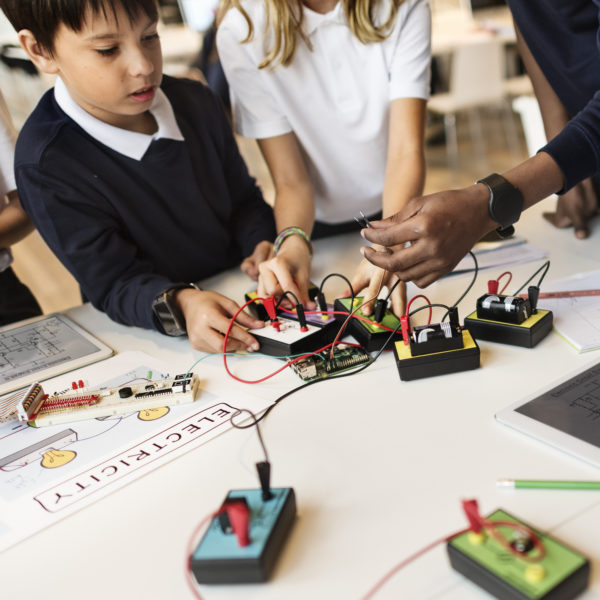I have been in education for 18 years and my strongest belief is that all children deserve a fresh start when they begin each school year. My classroom is a safe environment where students feel it’s acceptable to try, even if they’re not going to be successful the first time–and that certainly applies to STEM education.
Since the spring of 2014, I’ve worked with Stow-Munroe Falls City Schools in technology integration. The purpose of my position as an Academic Technology Specialist is to help teachers feel comfortable embedding new technology into their classrooms.
Working alongside teachers and helping their students with rapidly evolving technology is an incredible experience. Each year has been slightly different because students and teachers are, of course, different, and each year we move at the pace they need while building upon the skills from the previous year.
With the ever-changing best practices and new technology in education, I always try to update and adjust my own learning. I’m a lifelong learner and I believe my students should be as well.
That’s why our school gradually introduces STEM concepts, and coding in particular, to students as they progress through each grade level. We emphasize two learning stages to build fluid STEM integration from kindergarten to 4th grade:
Stage 1: Solving Problems Step-by-Step and Together
To broaden technology integration within STEM curriculum, we began to introduce computer science through the international movement, the ‘Hour of Code.’ One of my colleagues that taught STEM in my district introduced me to the program about four years ago. Since then, each year during the ‘Hour of Code’ I take the opportunity to introduce all grade levels to coding.
In our K-4 buildings, our goal is to integrate technology into the curriculum and enhance the lesson, activity or the critical thinking skills of the student, not just to use technology. Game-based learning programs like CodeMonkey, which focus on coding for kids, are usually their first experience with coding that introduces the problem-based learning mindset. We do the first couple levels together so I can model problem-solving questions I would ask myself. In this case I model out loud so they hear my thinking. The students then suggest methods to get a solution. If they say try eight steps, even though I know it’s 10 steps, I will try the eight steps and ask, “What should I do now?”
I also love having them act out the challenges on screen in their physical space. I often say, everybody stand up. I ask, “If we were the monkey in the game and needed the banana, how would we get there?” We physically do the steps and turns until we reach the solution together.
(Next page: The second stage of successful early STEM education)
Stage 2: Applying a Problem-Based Mindset to Cross-Curricular Lessons
Each day, we all need to take large amounts of information and figure out how to break them apart into doable tasks. We teach students these skills by weaving computer programming instruction into daily learning, rather than keeping the lesson isolated. Once students understand sequencing methods to reach a solution, we then pair up students to work together as they take turns as the lead in solving each problem.
I usually spend four sessions working with students to use CodeMonkey, and then students continue the series of challenges on their own. In this second stage of understanding computer programming languages, students are using so many problem-solving skills, critical thinking, mathematics and mapping skills. Many teachers utilize the math skills that are embedded in different levels of the game, such as using angles, degrees and measuring, into other lesson planning.
Our students in second grade have had lessons in technology and coding since they were in kindergarten. The difference in how they now approach problem-solving is stark. These students are not afraid to try. They come up with new ways to use technology that benefits their learning style, and many of them are open to teaching peers and leading tasks.
Students love when we teach them a new skill that incorporates technology–especially those who may struggle in a traditional learning format. Many are more on task and involved in their learning when they can use new tools and online applications. In a few of my classes we have students that have trouble participating in all the general education classes, but they are eager to get involved with game-based learning.
Students in third and fourth grade rush to sign up for the after-school STEM classes because each session only holds a small number of participants. When they have completed school tasks and have extra time, they often choose to do activities that involve computer science, and many students also utilize these accounts from home.
Teaching for the Future
I understand when teachers might be hesitant to try new tech products in their classroom – especially at the elementary level. It’s natural to want to know how to help every student, but with coding and other modern learning skills, we as teachers need to be the coaches. Recently I heard Alice Keeler talk as a keynote speaker at ITIP 2017 and she said, “teach the future, not your comfort level.”
It’s okay not to know the answer. Instead, be a guide on the side and give the support that our students need. Now is the time to celebrate mistakes that give way to true learning.
- The evolving requirements of a K-12 school network - April 24, 2024
- A bungled FAFSA rollout threatens students’ college ambitions - April 24, 2024
- How digital tools and AI can enhance social studies - April 23, 2024

